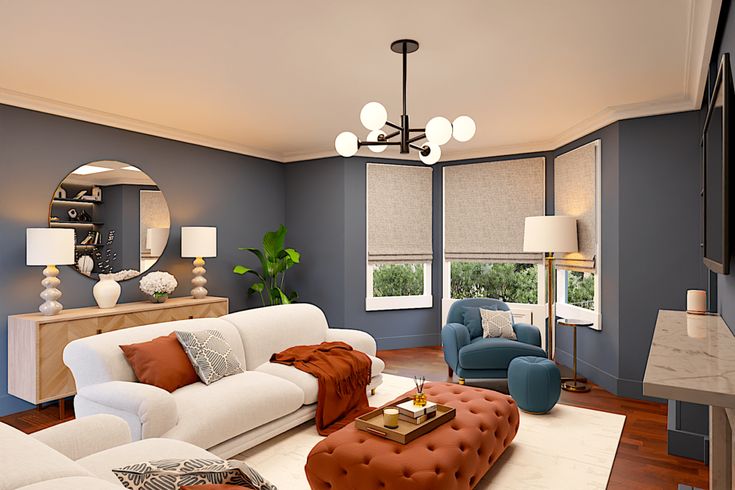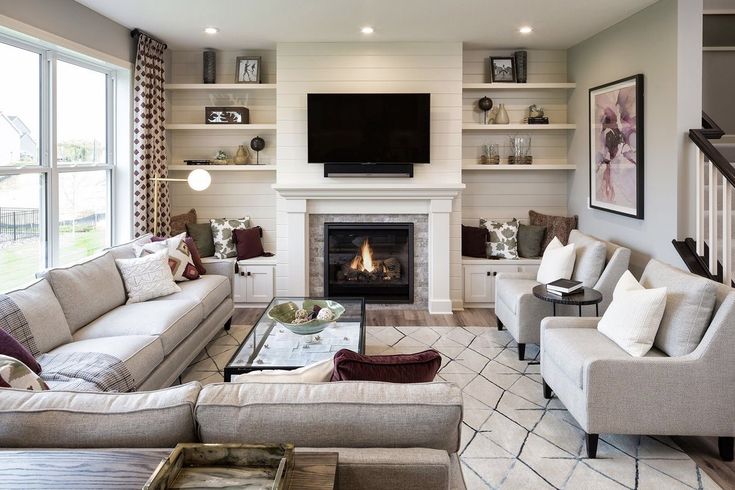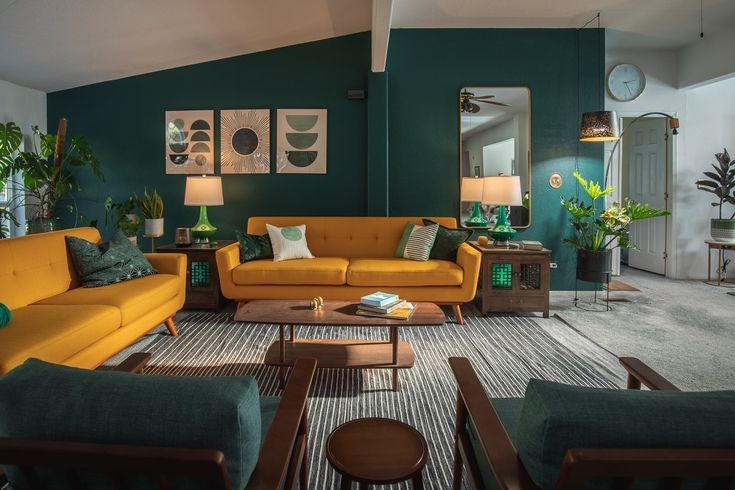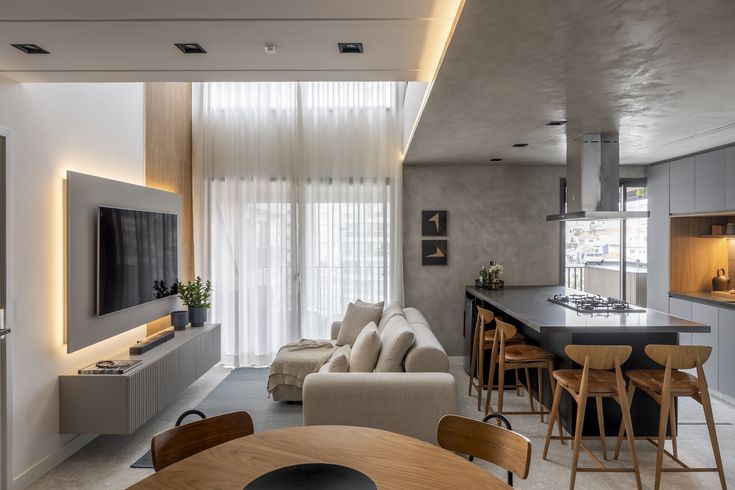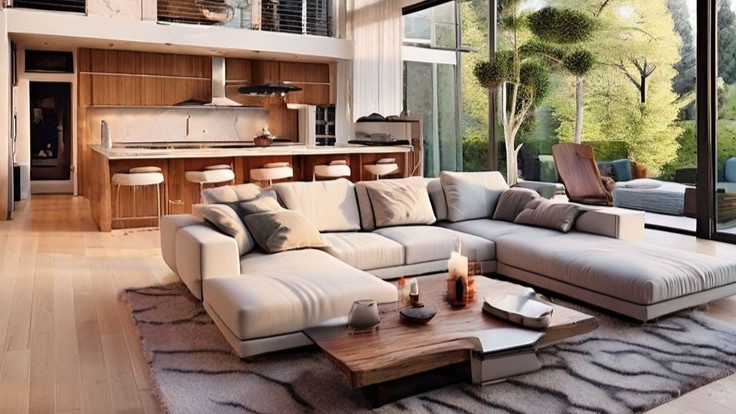Budget-Friendly Brilliance: Affordable Interior Design Tips for a Stylish Home
Budget-Friendly Brilliance: Affordable Interior Design Tips for a Stylish Home – Designing a home that is both beautiful and functional does not have to break the bank. With a little creativity, planning, and smart decision-making, you can transform your space into a stylish haven without overspending. This comprehensive guide explores affordable interior design tips that will help you create a chic environment that reflects your personality and lifestyle—all while keeping your budget in check.
In this article, we’ll dive into 2500 words of expert advice on designing a home with flair and functionality using budget-friendly methods. Whether you’re living in a small apartment or a spacious house, these strategies will inspire you to reimagine your living space without sacrificing quality or style.
1. Understanding Your Budget and Setting Realistic Goals
Assess Your Financial Parameters
The foundation of any budget-friendly interior design project begins with a clear understanding of your financial limits. Start by listing your available funds and categorizing your expenses. Ask yourself:
- What is the total budget allocated for this project?
- Which areas of the home require immediate attention?
- Can any existing items be repurposed or upcycled?
Having a well-defined budget not only sets the boundaries for your project but also prevents overspending by ensuring you prioritize key investments.
Prioritize Your Design Objectives
Before diving into the design process, list the features that matter most. Is it a cozy living area, a functional kitchen, or a serene bedroom retreat? Identifying your priorities allows you to allocate funds to high-impact areas. For instance, investing in a comfortable sofa or quality lighting might significantly enhance your space without demanding a complete overhaul.
Creating a Visual Wishlist
Inspiration is a powerful tool in interior design. Use platforms like Pinterest, Instagram, or home design blogs to create a visual wishlist. This collection of images will serve as a reference for your style preferences, from minimalist modern aesthetics to eclectic vintage vibes. Once you have a vision, align it with your budget to determine what’s feasible now and what might be saved for future projects.
2. Planning and Research: The Blueprint of Budget-Friendly Design
Develop a Detailed Floor Plan
A well-thought-out floor plan can drastically improve the functionality and flow of your home. Use free online tools or simple graph paper to sketch your room layouts. Focus on:
- Traffic Flow: Ensure there’s enough space for movement without overcrowding.
- Furniture Placement: Experiment with different arrangements to maximize comfort and functionality.
- Focal Points: Identify areas where you want to draw attention, such as a statement piece of art or a unique light fixture.
A precise floor plan helps you visualize changes and plan purchases accordingly.
Research Affordable Options and Alternatives
The internet is a treasure trove of resources for affordable interior design ideas. Researching before you shop can reveal budget-friendly alternatives that still look high-end. Look for:
- Online Marketplaces: Websites like Wayfair, Overstock, and Amazon offer competitive prices on home furnishings.
- Secondhand Treasures: Consider thrift stores, garage sales, and online marketplaces such as Facebook Marketplace or Craigslist for unique finds.
- DIY Solutions: Many stylish home decor elements can be created on your own with minimal supplies and a bit of creativity.
Leverage Seasonal Sales and Discounts
Timing can make a significant difference in your spending. Keep an eye out for seasonal sales, clearance events, and discount days at your favorite stores. Sign up for newsletters and follow social media accounts of design retailers to stay informed about promotions and exclusive offers.
3. DIY Projects: Personalizing Your Space on a Budget
Embrace the Power of DIY Decor
Do-it-yourself projects not only save money but also add a personal touch to your home. Whether you’re painting a piece of furniture or creating wall art, DIY projects allow you to customize items exactly to your taste. Some popular DIY ideas include:
- Repurposing Old Furniture: Sand, paint, or reupholster an old chair or table to give it a fresh, modern look.
- Creating Custom Wall Art: Use inexpensive canvases, fabric, or even recycled materials to craft unique pieces of art.
- Handmade Decor Accessories: Sew your own cushion covers, throw pillows, or curtains to add personality to your space.
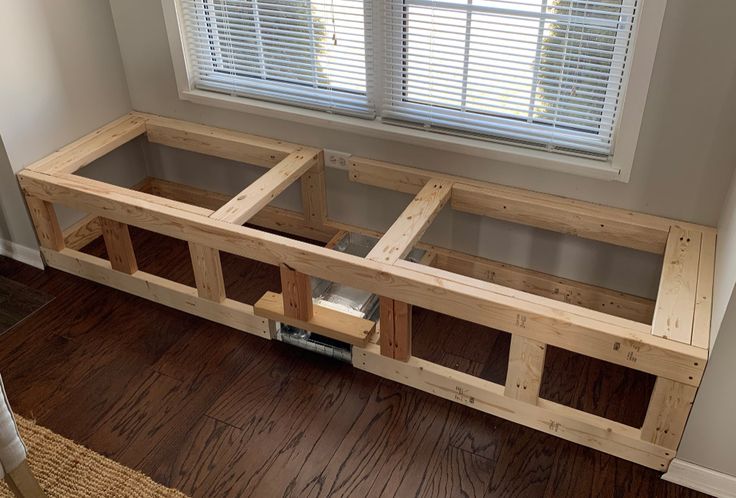
Learning New Skills
Before starting any DIY project, invest some time in learning the necessary skills. There are countless free tutorials available on YouTube and design blogs that can guide you through various processes. By mastering basic techniques, you can confidently take on projects that enhance your home’s style without the expense of hiring professionals.
Safety and Quality Considerations
While DIY projects are cost-effective, safety should always be a priority. Ensure you use the proper tools and materials, and don’t hesitate to consult experts for guidance on more complicated tasks. Quality craftsmanship will not only improve the look of your home but also ensure longevity, preventing the need for frequent repairs or replacements.
4. Smart Shopping: Where to Find Quality on a Budget
Discover Affordable Furniture Retailers
The modern consumer has many options when it comes to affordable furniture. Retailers such as IKEA, Target, and Walmart offer stylish pieces that fit various budgets. Focus on pieces that are timeless and versatile, allowing you to mix and match with other decor elements.
Thrift Stores and Consignment Shops
Thrift stores and consignment shops are gold mines for budget-friendly interior design enthusiasts. These outlets often have unique pieces that add character and history to your home. When shopping secondhand, inspect items for quality and potential repair needs. Sometimes a little elbow grease can transform a worn-out piece into a stunning focal point.
Online Auctions and Marketplaces
Platforms like eBay, Etsy, and local Facebook groups provide opportunities to buy affordable, vintage, or even bespoke furniture. These venues are particularly useful if you’re looking for items that add a personal touch to your space. Always check seller reviews and ratings to ensure a positive buying experience.
The Art of Negotiation
Don’t be afraid to negotiate prices, especially at local flea markets or antique shops. A friendly conversation can sometimes lead to significant savings. Developing a good rapport with shop owners may also provide access to future discounts or insider tips on upcoming sales.
5. Repurposing and Upcycling: Sustainable and Stylish Solutions
The Benefits of Repurposing
Repurposing existing furniture or decor items is not only environmentally friendly but also economically wise. By giving new life to old pieces, you can achieve a unique look that distinguishes your home from the typical store-bought aesthetic. Some ideas include:
- Transforming Wooden Pallets: Convert pallets into coffee tables, garden furniture, or even vertical gardens.
- Repainting and Refinishing: Give a worn-out dresser or bookshelf a makeover with a fresh coat of paint and updated hardware.
- Creative Storage Solutions: Use vintage suitcases, crates, or baskets as stylish storage options that double as decorative accents.
Upcycling in Practice
Upcycling takes repurposing to the next level by creatively combining old and new elements. For example, consider using reclaimed wood for a custom headboard or turning an old ladder into a bookshelf. These projects often involve minimal investment and yield high-impact results. Upcycling not only reduces waste but also provides an opportunity to express your creativity and personal style.
Sustainability and Budget Benefits
Incorporating sustainable practices in your interior design is a win-win situation. It benefits the environment while keeping costs low. Opt for eco-friendly materials, invest in energy-efficient lighting, and choose sustainable decor items that last. Over time, these choices reduce your overall expenses through lower maintenance and energy costs.
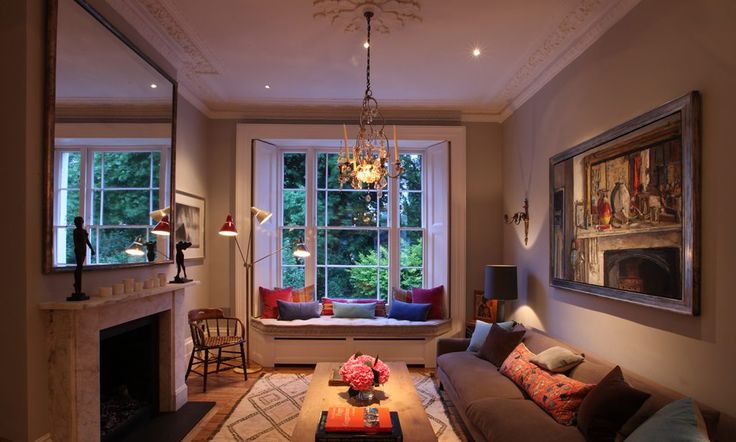
6. Lighting and Ambience: The Unsung Heroes of Interior Design
The Role of Lighting in Design
Lighting is a critical element that can dramatically alter the mood and functionality of a space. Strategic lighting can make even the smallest room appear larger and more inviting. Consider these key tips:
- Layered Lighting: Use a combination of ambient, task, and accent lighting to create a dynamic and flexible environment.
- Energy Efficiency: Choose LED bulbs or energy-saving fixtures to reduce electricity costs without compromising on style.
- Natural Light: Maximize natural light by using light-colored window treatments and strategically placing mirrors to reflect sunlight.
Affordable Lighting Solutions
Budget-friendly lighting doesn’t mean compromising on style. Look for modern fixtures at discount home stores or consider DIY options like creating pendant lights from recycled materials. Thrift stores and online marketplaces can also yield hidden gems that add character to your home without a hefty price tag.
Creating Ambience with Accessories
Beyond functional lighting, accessories such as candles, fairy lights, and lanterns can enhance the overall ambience of a room. These inexpensive additions help set the mood for relaxation and entertainment, turning ordinary evenings into memorable experiences.
7. Furniture Arrangement: Maximizing Space and Functionality
Planning Your Layout
The arrangement of furniture can influence the perception of space and functionality in your home. Start by measuring your room and creating a scaled diagram. Consider the following tips:
- Focal Points: Position key pieces, such as a sofa or dining table, in relation to a focal point like a fireplace or window.
- Traffic Flow: Ensure that there is enough space between pieces for easy movement. Avoid overcrowding by selecting furniture that fits the scale of your room.
- Flexibility: Use modular furniture that can be rearranged to suit different occasions or needs. This approach allows you to adapt your space as your lifestyle evolves.
Mixing and Matching Styles
Don’t be afraid to mix styles when arranging your furniture. Combining modern and vintage pieces can add depth and character to your home. The key is to maintain balance—use neutral colors and textures as a unifying element while incorporating bold accents to create visual interest.
The Power of Statement Pieces
A statement piece of furniture or decor can serve as the anchor of your room. Whether it’s an intricately designed coffee table or an eye-catching piece of art, these elements draw attention and set the tone for the rest of the space. When working with a budget, consider investing in one or two quality statement pieces and supplementing them with more affordable, complementary items.
8. Color Schemes: Transforming Spaces with the Right Palette
The Psychology of Colors
Color has a profound impact on mood and perception. Choosing the right palette can make your home feel more inviting, spacious, and cohesive. Warm tones like red and orange evoke energy and coziness, while cool hues such as blue and green create a calming atmosphere. Neutral shades provide a versatile backdrop that works well with almost any style.
Budget-Friendly Painting Tips
A fresh coat of paint is one of the most cost-effective ways to revitalize a room. Consider these strategies:
- Accent Walls: Instead of repainting an entire room, focus on one wall as a focal point. An accent wall in a bold color can transform the space without the expense of a full makeover.
- DIY Techniques: Learn creative painting techniques, such as stenciling, sponging, or ombre effects, to add texture and depth at a low cost.
- Eco-Friendly Options: Choose paints that are low in volatile organic compounds (VOCs) to improve indoor air quality and create a healthier living environment.
Coordinating with Accessories
Integrate your chosen color scheme with accessories like cushions, rugs, and artwork. These elements can easily be updated or replaced, allowing you to experiment with different looks without committing to a permanent change. Seasonal decor updates can also breathe new life into your home while keeping your budget in check.

9. Incorporating Nature: Biophilic Design on a Budget
The Benefits of Natural Elements
Bringing nature indoors not only enhances the aesthetic appeal of your home but also improves air quality and overall well-being. Biophilic design—incorporating natural elements into interior spaces—can be achieved on a budget with a few thoughtful additions.
Affordable Ways to Add Greenery
- Houseplants: Start with low-maintenance plants such as succulents, snake plants, or pothos. They are inexpensive, easy to care for, and add a splash of color and life to any room.
- DIY Planters: Create your own planters using repurposed materials like mason jars, old tin cans, or reclaimed wood. Customize them with a bit of paint or fabric to match your decor.
- Herb Gardens: If you have a kitchen window, consider growing an herb garden. Fresh herbs not only enhance your cooking but also serve as attractive, aromatic decor.
Natural Materials and Textures
Integrate natural materials such as wood, stone, and bamboo in your decor. Opt for furniture or accessories made from reclaimed wood or natural fibers like jute and cotton. These elements bring warmth and texture to your home without the high cost of luxury materials.
10. Utilizing Multifunctional Spaces for Modern Living
The Rise of Multifunctional Furniture
With the growing trend of smaller living spaces and urban living, multifunctional furniture has become a staple of affordable interior design. Look for pieces that serve more than one purpose, such as a sofa bed, an ottoman with storage, or a dining table that doubles as a workspace. These pieces maximize functionality without sacrificing style.
Creative Solutions for Small Spaces
- Convertible Rooms: Designate areas that can easily transform to serve different needs throughout the day. A guest room might also function as an office or a gym, with minimal adjustments.
- Hidden Storage: Incorporate built-in shelves, under-bed storage, and multi-use furniture to reduce clutter and maintain a clean, organized look.
- Flexible Layouts: Experiment with furniture that is lightweight and easy to move. Rearranging pieces based on the time of day or specific activities can help create a dynamic, adaptable living space.
The Impact on Aesthetic and Budget
Multifunctional design not only enhances the usability of your space but also contributes to a sleek, modern aesthetic. By investing in versatile pieces, you reduce the need for multiple items, leading to cost savings in the long run. This approach is especially beneficial in apartments or smaller homes where every square foot counts.
11. Creative Wall Treatments: More Than Just Paint
Affordable Alternatives to Wallpaper
While wallpaper can dramatically change a room’s look, it can sometimes be expensive. Fortunately, there are budget-friendly alternatives that mimic the effect of wallpaper:
- DIY Wall Decals: Create your own decals using stencils and painter’s tape. This technique allows for customization and can be easily removed or changed.
- Fabric Panels: Stretch fabric over inexpensive frames or boards to create a unique, textured wall covering. This method is particularly effective in bedrooms and living areas.
- Washi Tape Designs: Use decorative washi tape to form geometric patterns or accent lines on your walls. This technique is not only affordable but also allows you to experiment with different designs without permanent commitment.
Statement Wall Art on a Budget
A statement wall can serve as the centerpiece of your room without requiring a complete redesign. Consider these ideas:
- Gallery Walls: Combine a mix of affordable art prints, family photos, and DIY art pieces to create a personalized gallery.
- Mirrors: Strategically placed mirrors can reflect light and create the illusion of more space. Look for unique, inexpensive mirror designs that double as art.
- Hand-Painted Murals: If you’re feeling artistic, consider painting a mural on one wall. With a bit of creativity and planning, you can create a stunning visual impact at a fraction of the cost of custom wallpaper.
12. The Final Touches: Accessories and Personalization
Curating a Collection of Affordable Accessories
Accessories are the finishing touches that complete your interior design. They provide opportunities to add color, texture, and personality to your space. Consider these ideas for curating an affordable accessory collection:
- Thrift and Flea Markets: Find unique pieces such as vintage vases, decorative bowls, or quirky sculptures.
- Handmade Items: Support local artisans or explore online marketplaces like Etsy for handmade decor that adds a personal touch.
- Seasonal Updates: Rotate accessories based on seasons or holidays. This not only refreshes the look of your home but also allows you to experiment with new trends without significant investment.
Personalization: Reflecting Your Style
Your home should be a reflection of your unique personality. Personal touches, such as family photos, travel souvenirs, or heirloom pieces, add depth and meaning to your space. Incorporate these elements thoughtfully:
- Curated Displays: Instead of scattering personal items throughout your home, create designated areas or shelves that showcase your collections.
- Mix and Match: Blend modern pieces with vintage finds to create a dynamic and layered look that tells your story.
- Customized DIY Projects: Whether it’s a hand-painted sign or a repurposed piece of furniture, adding a touch of personalization elevates the overall design.
13. Maintaining Your Budget-Friendly Home
Regular Updates and Refreshes
Interior design is an ongoing process. Regularly refreshing your decor can keep your home feeling new without a complete overhaul. Simple updates such as changing cushion covers, swapping out throw blankets, or rearranging furniture can make a big difference.
Smart Maintenance Practices
Invest in quality items that are built to last, even if they cost a bit more upfront. Good maintenance practices, like regular cleaning, periodic touch-ups on paint, and careful handling of furniture, ensure that your investment remains durable over time. This proactive approach prevents the need for costly replacements and repairs.
Embracing Imperfections
A truly stylish home isn’t about perfection—it’s about creating a space that feels lived-in, authentic, and reflective of your journey. Embrace imperfections as part of your story, and remember that every mark or repair can add character rather than detract from your overall design.
Conclusion
Creating a stylish home on a budget is entirely achievable with thoughtful planning, creativity, and a willingness to explore unconventional options. From understanding your budget and setting realistic goals to exploring DIY projects, smart shopping, and sustainable design practices, every step of the process is an opportunity to infuse your personality into your space.
“Budget-Friendly Brilliance: Affordable Interior Design Tips for a Stylish Home” is more than just a guide—it’s a testament to the idea that great design is accessible to everyone. By leveraging affordable solutions, repurposing what you already have, and embracing both modern trends and timeless elements, you can create an environment that is both functional and aesthetically pleasing.
Remember, interior design is a journey. Start with small, manageable changes, and gradually expand your vision as your budget allows. Over time, you’ll find that your home becomes a true reflection of your style and values—a place where creativity, comfort, and affordability converge in perfect harmony.
By implementing these budget-friendly tips, you’re not only saving money but also fostering a sense of accomplishment as you transform your living space into a stylish, personalized retreat. So roll up your sleeves, get inspired, and embark on your journey toward creating a home that radiates brilliance without breaking the bank.
Recap: Key Takeaways for Affordable Interior Design
- Budget Planning: Clearly define your financial parameters and prioritize your design goals.
- Strategic Research: Use free tools and online resources to map out your floor plan and discover affordable alternatives.
- DIY Projects: Personalize your space with do-it-yourself projects while learning new skills to save costs.
- Smart Shopping: Explore affordable retailers, thrift stores, and online marketplaces for quality furniture and decor.
- Repurposing & Upcycling: Embrace sustainable practices by repurposing existing items and upcycling old furniture.
- Lighting & Ambience: Utilize layered lighting and ambient accessories to enhance the mood of your space.
- Furniture Arrangement: Optimize layout and flow by strategically placing furniture and choosing multifunctional pieces.
- Color & Decor: Choose a cohesive color palette and integrate creative wall treatments to refresh your home.
- Nature & Sustainability: Incorporate natural elements to boost aesthetic appeal and improve well-being.
- Personalization: Reflect your unique personality with accessories, curated collections, and personalized DIY touches.
With these insights, your journey to creating a chic, budget-friendly home becomes not only manageable but also an exciting opportunity to express your creativity and style.
In conclusion, remember that your home is your sanctuary—a place where every design decision contributes to your overall well-being. Affordable interior design isn’t about cutting corners; it’s about making smart choices that reflect both your financial realities and your creative aspirations. With a little ingenuity and persistence, you can achieve a space that is both beautiful and budget-friendly. Enjoy the process, and let every design decision bring you one step closer to the stylish home you’ve always dreamed of.
Now is the time to embrace Budget-Friendly Brilliance. Start small, dream big, and transform your home into a masterpiece of affordable interior design. Happy decorating!

